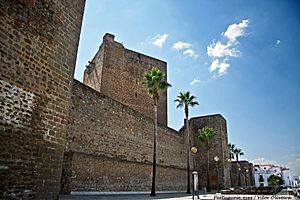Siege of Olivença facts for kids
Quick facts for kids Siege of Olivença |
|||||||
|---|---|---|---|---|---|---|---|
| Part of Peninsular War | |||||||
 Castelo de Olivença was damaged during the Peninsular War. |
|||||||
|
|||||||
| Belligerents | |||||||
| Commanders and leaders | |||||||
| Jean-de-Dieu Soult | Gabriel de Mendizábal Don Manual Herck |
||||||
| Strength | |||||||
| 6,000 | 4,361 | ||||||
| Casualties and losses | |||||||
| 15 killed, 40 wounded | 200 killed 4,161 taken captive |
||||||
The Siege of Olivença was a battle that happened from January 19 to 22, 1811. French General Jean-de-Dieu Soult captured a Spanish fort called Olivença in western Spain. This event was part of the Peninsular War.
General Soult was planning to attack a stronger fort in a city called Badajoz. But he had to change his plans. He sent some of his fast horse soldiers (called light cavalry) to capture another town, Mérida. He also left some other horse soldiers (called dragoons) to watch the fort at Badajoz. Then, Soult marched with the rest of his army to surround Olivença.
The Plan for Olivença
Wellington was a British general. He had told the Spanish commander, General Pedro de La Romana, to either destroy the fort at Olivença or fix it up and put many soldiers there. General La Romana then told General Mendizabal to destroy the fort.
However, Mendizabal did not follow this order. Instead, he made the fort stronger by adding four groups of foot soldiers (called battalions). General Soult arrived on January 11. He found the fort had many soldiers, but it was still not very strong.
The Attack Begins
The French army's heavy cannons arrived on January 19. By January 22, they had reopened a hole in the fort's walls. This hole had been poorly repaired before. The soldiers inside the fort gave up on January 23. Over 4,000 Spanish troops were captured.
After the Siege
General Soult now faced a tough situation. He had many horse soldiers, about 4,000. But he had to send two groups of foot soldiers to take the captured Spanish soldiers back to Seville, which the French controlled. This left him with only 5,500 foot soldiers for his next battles.
His special equipment for sieges had started to arrive. However, one of his main groups of foot soldiers was still missing. This made his army weaker.
Moving to Badajoz
Even with these problems, Soult decided to attack Badajoz next. He hoped that General Wellington would send help to the Spanish fort there. This would make the Allied forces weaker against another French general, Masséna.
On January 26, Soult left for Badajoz. He sent General Marie Victor Latour-Maubourg with six groups of horse soldiers. They crossed the Guadiana River to block the fort's northern side. By January 27, the first siege of Badajoz had begun.
See also

